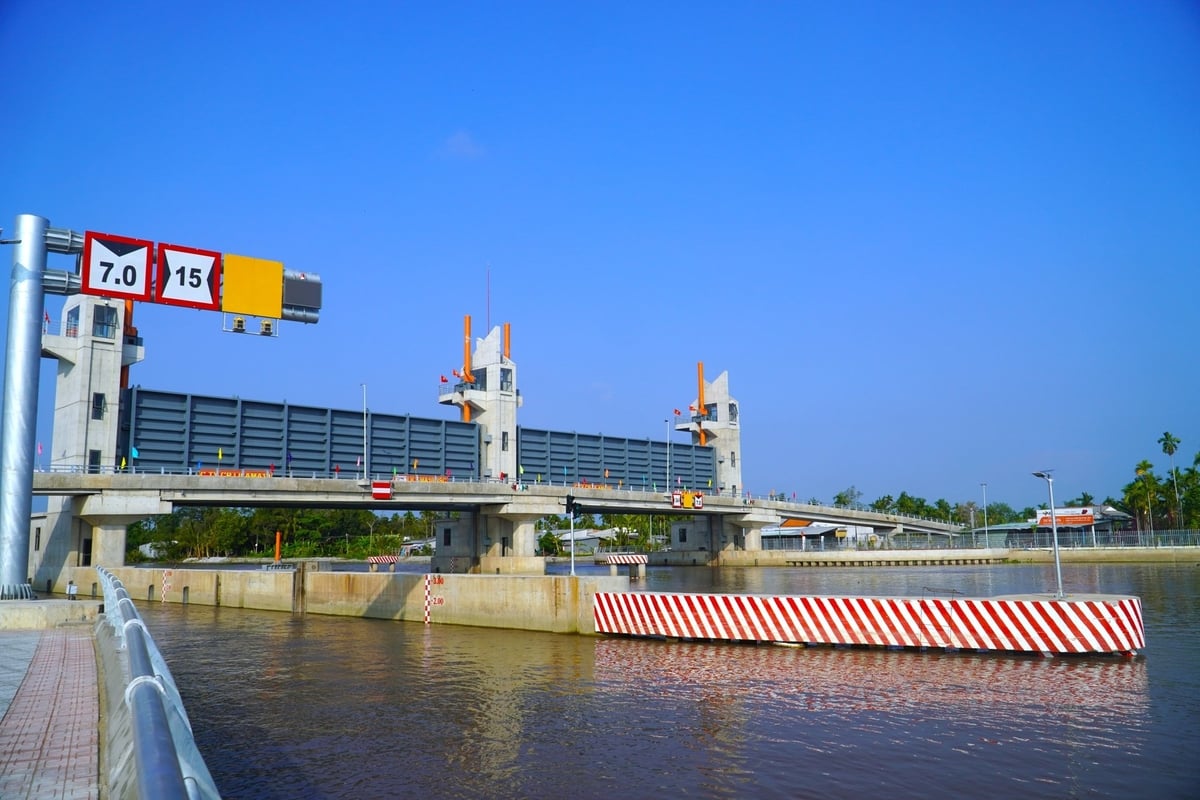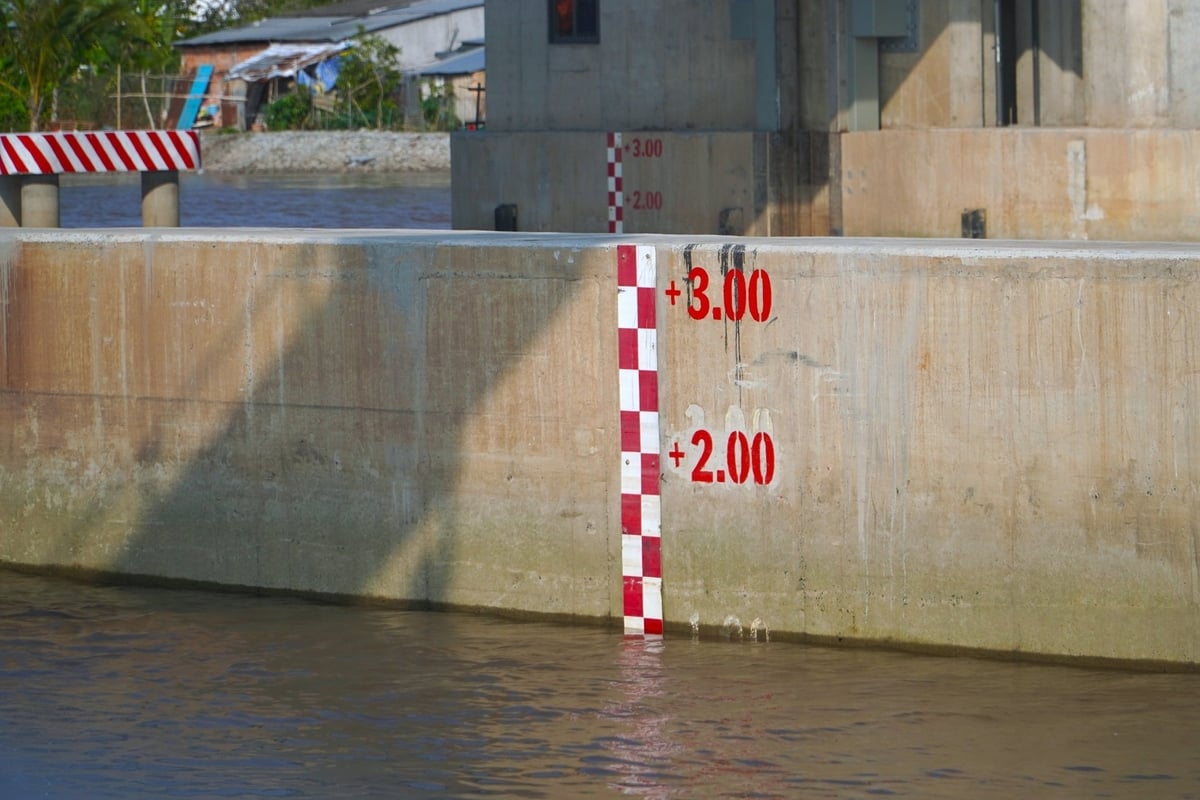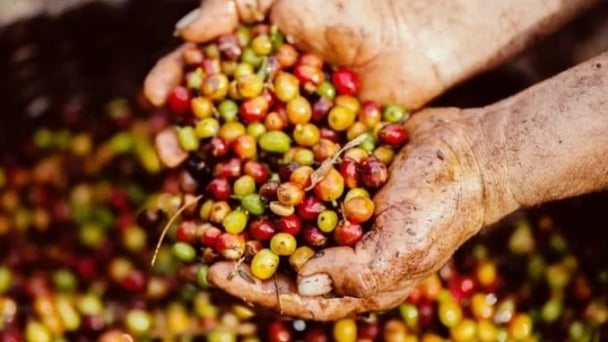June 18, 2025 | 07:55 GMT +7
June 18, 2025 | 07:55 GMT +7
Hotline: 0913.378.918
June 18, 2025 | 07:55 GMT +7
Hotline: 0913.378.918
Located in the lower reaches of the Hau River, Cu Lao Dung district (Soc Trang province) is an area where fresh, brackish, and saline waters converge. Therefore, the operation of the irrigation system has its own particularities, requiring coordination to serve shrimp farming and fruit cultivation zones effectively.
Before 2015, water flow in the islet still followed the natural rhythm of "favorable rain and gentle winds," so local people did not face many difficulties in obtaining fresh water for production. However, during the 2015-2016 dry season, salinity intruded deeply and rapidly, catching the community unprepared.

Loudspeakers were the main means of disseminating salinity and drought forecasts in Soc Trang before 2015. Photo: Kim Anh.
Recalling those difficult days, Mr. Nguyen Van Dac, Head of the Agriculture and Environment Department of Cu Lao Dung District, could not hide his emotion. He recounted that back then, access to salinity forecast bulletins sent from the province was mainly through fax or paper documents, issued every 2-3 days.
The Soc Trang Provincial Irrigation Sub-Department currently manages 160 large sluices (over 1.5 meters), out of more than 650 sluices across the entire province. During the 2025 dry season, despite salinity levels being higher than the multi-year average, thanks to accurate forecast bulletins, the specialized sector was able to timely direct the operation of these sluices.
Social networks were not yet developed, so the dissemination of forecast bulletins to the people was mainly done via local radio stations. However, the infrastructure at that time was limited, with loudspeakers available only in some areas. The specialized agencies had to combine efforts by organizing community meetings or direct training sessions, but participation was not always full. Due to slow information reception, the supply of fresh water and salinity prevention were not timely, leading to considerable damage.
At that time, Cu Lao Dung was just one of many localities in Soc Trang province affected by losses because the salinity forecasting work lagged behind reality. According to statistics from the Soc Trang Department of Agriculture, the 2015-2016 salinity intrusion caused damage to nearly 28,000 hectares of rice, 4,000 hectares of fruit trees, and 215 hectares of vegetables.
Learning from past experiences, in the following years, the province boldly invested in many response works such as upgrading dikes, strengthening the system of sluices and reservoirs, developing early response scenarios, and investing in many salinity monitoring points on the main river branches and key production areas. Especially, the province focused on training and transferring scientific and technical knowledge to the people.
Thanks to that, in the dry season of 2019-2020, the salinity forecasting work showed clear improvements. Damage was reduced to just over 500 hectares of rice, mainly due to off-season rains causing late sowing and failure to avoid salinity.

Rach Mop Au sluice – a key irrigation work in Soc Trang, was put into operation, effectively preserving fresh water for the Ke Sach area and part of Long Phu district. Photo: Kim Anh.
Mr. Pham Tan Dao, Head of the Soc Trang Irrigation Sub-Department, stated that the operation of the irrigation system heavily depends on drought and salinity intrusion forecast bulletins. Currently, bulletins from both central and local meteorological agencies are regularly updated and maintained daily throughout the dry season (from January to May).
As soon as they are received, the unit forwards them to the District Steering Committees for Natural Disaster Prevention and Control, as well as to Soc Trang Newspaper and Soc Trang Radio and Television Station, to promptly inform local professional agencies and the public. At the same time, the Southern Institute for Water Resources Planning also provides strategic, region-wide bulletins. As a result, Soc Trang can proactively plan for freshwater storage early on.
According to the Southern Institute for Water Resources Planning, since 2010, drought and salinity intrusion events in the Mekong Delta have occurred frequently and with increasing severity. Although the government and local authorities have made substantial investments to complete the irrigation infrastructure systems, they still fall short of fully meeting the requirements for disaster prevention and control.
In this context, hydrometeorological forecasting plays a pivotal role, helping localities develop water use plans and effectively respond to various forms of natural disasters. In particular, saline intrusion forecasting - a growing challenge due to the compounded impacts of climate change, sea level rise, and the operation of upstream hydropower reservoirs on the Mekong River is becoming increasingly critical.
Mr. Do Duc Dung, Director of the Southern Institute for Water Resources Planning, noted that forecasting not only supports the planning of appropriate irrigation system operations but also enhances the capacity for water storage and intake.

Mr. Do Duc Dung, Director of the Southern Institute of Water Resources Planning, emphasizes the important role of salinity forecasting work. Photo: Kim Anh.
Currently, with the support of modern hydrological-hydraulic models, combined with remote sensing technology and artificial intelligence (AI), hydrometeorological forecasting is becoming increasingly accurate, enabling real-time predictions of salinity and drought. This forms a solid foundation for shifting from passive response to proactive adaptation, aiming toward integrated water resource management across both river basins and inter-regional systems.
As evidence, the 2019-2020 saline intrusion occurred earlier, penetrated deeper, and lasted longer compared to the 2015-2016 period. However, the damage was significantly lower. This confirms that the capacity for drought and salinity forecasting has been improved and enhanced. More importantly, it reflects the proactive and effective coordination between central and local authorities in production planning, infrastructure operation, and public communication for disaster response.

Salinity forecast bulletins help localities proactively operate irrigation works to minimize damage. Photo: Kim Anh.
Currently, in addition to hydrometeorological forecasts provided by the National Centre for Hydro-Meteorological Forecasting, the Southern Institute for Water Resources Planning also issues forecasts and warnings on flood-season water sources. Meanwhile, the Southern Institute of Water Resources Research provides updated forecasts on salinity and drought. These information sources serve as a scientific basis for the Ministry and localities to develop production plans and operational scenarios for infrastructure tailored to specific times and regions.
Thanks to timely access to salinity and drought forecast information, many localities such as Ben Tre, Tra Vinh, Soc Trang, and Long An took early action, clearly demonstrating a mindset of “avoiding salinity, welcoming freshwater,” thereby minimizing damage to production and daily life.
From this practical experience, Mr. Dung emphasized that a key lesson is the need to integrate salinity and drought forecasting early in the decision-making process, specifically starting in late September or early October, before the onset of the winter-spring crop season.
At the same time, forecast information should be institutionalized in plans and executive directives, while strengthening inter-sectoral coordination and improving the communication of information to district and commune levels to enhance response effectiveness.

Localities in the Mekong Delta need to strengthen coordination in operating interconnected works; enhance forecasting capacity for salinity intrusion in particular and natural disasters in general. Photo: Kim Anh.
Southern Institute of Water Resources Planning also proposed establishing a shared data management mechanism among provinces, cities, and ministries, focusing on hydrology, meteorology, water levels, salinity, and operation of water works.
At the same time, the Institute recommended that the Government promote negotiations so that the upstream countries of the Mekong River share information on water use and reservoir operations. Additionally, it is necessary to allocate a budget for upgrading the automatic monitoring network and supporting localities in training and applying forecasting models.
Translated by Phuong Linh
![Turning wind and rain into action: [7] Early disaster warnings help marine farmers minimize losses](https://t.ex-cdn.com/nongnghiepmoitruong.vn/608w/files/news/2025/06/17/z6704423696987_15fd32ffc26d590d204d520c9dac6786-nongnghiep-142942.jpg)
(VAN) In recent years, thanks to early disaster warnings and forecasting, marine farmers in Khanh Hoa province have been able to reduce risks and losses, thereby improving production efficiency.
![Turning wind and rain into action: [6] ‘Four on-the-spot’ disaster management software](https://t.ex-cdn.com/nongnghiepmoitruong.vn/608w/files/news/2025/06/17/e5a48259d6a262fc3bb3-nongnghiep-183800.jpg)
(VAN) By simply activating the scenario on the disaster management software, the relevant authorities immediately know how many households need to be evacuated, where to evacuate them to, and by what means of transportation…
![Turning wind and rain into action: [5] Hue applies modern technology in disaster forecasting](https://t.ex-cdn.com/nongnghiepmoitruong.vn/608w/files/news/2025/06/17/z6704423696987_15fd32ffc26d590d204d520c9dac6786-nongnghiep-093938.jpg)
(VAN) In Hue city, modern technology has recently been applied in meteorological and hydrological forecasting and warning, helping to reduce the damage caused by natural disasters.

(VAN) A cutting-edge farming technique being implemented on an experimental ranch in Arizona's Sonoran Desert has already saved a billion gallons of water over five years, according to Civil Eats.

(VAN) Poultry and pig production and the environment can be boosted through enhanced water technology, according to new research.

(VAN) Coffee prices on June 16, 2025 are unchanged. In Vietnam, local trading prices are holding steady, ranging around VND 112,000 – VND 112,500/kg.